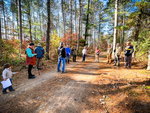





On a recent morning, a collection of concerned citizens pulled on their boots and flannels and got ready for another session of hiking and learning, with the Monroe County Invasive Species Working Group (MCISWG). The group meets periodically to discuss and address ecological concerns, including and especially the state of invasive and native species in the area. The group has a number of working sites and volunteer opportunities for anyone who wants to get involved.
A wildlife biologist, an endangered species biologist, land owners, goat herders, conservationists, educators, local parents, retirees and even a toddling two year old naturalist in training, were among the attendees at the meeting, led by local Outdoor Education Coordinator, John Sullivan and DNR Forester, Clint Gilman.
“We have so many local experts,” gushes Connie Weedman, a local retiree and volunteer with MCISWG, who is using her retirement to learn more about local ecology. Connie continued on about why she joined the group, “I want to learn more about what’s at my feet, and at eye level, too. The interconnectedness of things. Native bees depend on native plants. Some plants depend on one bug. There’s a lot to learn about here and I think it’s a lot more fun than
crossword puzzles!”
Endangered Species Biologist, Jessup Weichelt, who works at Fort McCoy, is also involved in the group. Jessup explains that he helps monitor a number of state and federally endangered species, including the prickly pear, Karner butterfly, rusty-patched bumble bee, and the graywolf. The success of these species depends on the success of local habitats.
Vern Klingbeil, of Goats on the Go, in Trempealeau and Brandy Ender, of Goats on the Go, in La Crosse, explain to the group that they offer a unique solution to help in eradicating invasive species of plants: goats. They can bring goats to sites in the region and fence them off. They then provide water and monitoring for the goats, while the goats much away on the unwanted plants. The goats forage and dine on the invasive species, like buckthorn, reducing the need for tools or herbicides.
Land owners, Norb and Patsy Brown, explain that they have joined the group because, as land owners, they want to learn about the best practices for land management and local ecology. Monroe County Invasive Species Working Group seeks to educate the public and private interests in Monroe County on the impacts of invasive species, and to conduct and promote the management of invasive species, by interagency and private citizen action.
Their Vision Statement is, “Continuing to inform, promote and conduct the management of invasive species by interagency and private citizenry action. Using public and private collaboration to reduce or eliminate the impacts of all invasive species that affect the resources of Monroe County.”
Mic Armstrong and Eric Ressel, USDA Soil Conservation Technicians based in Sparta, educator John Sullivan, and naturalist, Joey Esterline, were all happy to point out invasive species, as well as native plants, along the hike. Mic pulled out some pink identification tape, to tie onto some invasive barberry, for removal later. A new crop of garlic mustard, brought to the U.S. by Europeans because it was delicious and easy to grow, in fact grows too easily, and for years has been spreading and choking out local habitat. The same goes with buckthorn, Japanese knotweed, ornamental maple, purple loosestrife, poison hemlock, and multiflora rose, which spread easily, choking out our pristine native driftless habitat.
While invasive plants have taken over so much of our natural landscape, there is hope, thanks to the hard work of volunteers and the knowledge shared by groups like MCISWG. On Saturdays, from May through October, the group teaches Sparta Farmers Market attendees with an “Invasive of the Week” demonstration, in Mueller Square. MCISWG also offers educational outreach to clubs, associations, and groups, such as garden clubs, youth groups such as 4-H, town associations and more.
There are volunteer opportunities coming up in November to help with a troublesome ornamental maple, and Mic Armstrong offers this call to action: “November is finally here and we can start working on our long term project to manage an 80 acre-plus infestation of Amur Maple. It’s an unruly ornamental plant you can still purchase under its cultivar name, Flame Maple. The straight species is already listed as restricted, so it is no longer legally available in Wisconsin.”
We will be meeting to cut and treat the Amur Maple that we have spreading along the bike trail, east of Speed’s Bikes and the area around the campground, on the other side of the interstate. We need people to help drag, and pile the brush our chainsaw operators (certified and approved) leave in their wake. If you are not a certified sawyer, we still can do stuff with hand tools and reciprocating saws, but piling and dragging is needed the most. We would also accept moral support. It would actually be great if someone wanted to greet passing hikers with our leaflets, explaining who we are and what Amur Maple does. We will have a clipboard for anyone interested in signing up for future events.
We will be sending out an email, explaining the required paperwork to be a volunteer and hand out some reading on herbicides. It will also detail where and when we will meet. Please rsvp, so we know how many people we will need the famous cookie bars for.
If you, a group you are involved in, or someone you know who would like to learn more about invasive and native plants, best practices concerning local ecology, volunteer opportunities, or to book a presentation, you may reach out to Ben Anderson, of the Monroe County Invasive Species Working Group, at 608-269-8974. Check out the MCISWG website at https://www.co.monroe.wi.us/departments/land-conservation/invasive-species-workgroup and/or email Mic Armstrong, at John.armstrong@wi.usda.gov
Comments
No comments on this item Please log in to comment by clicking here